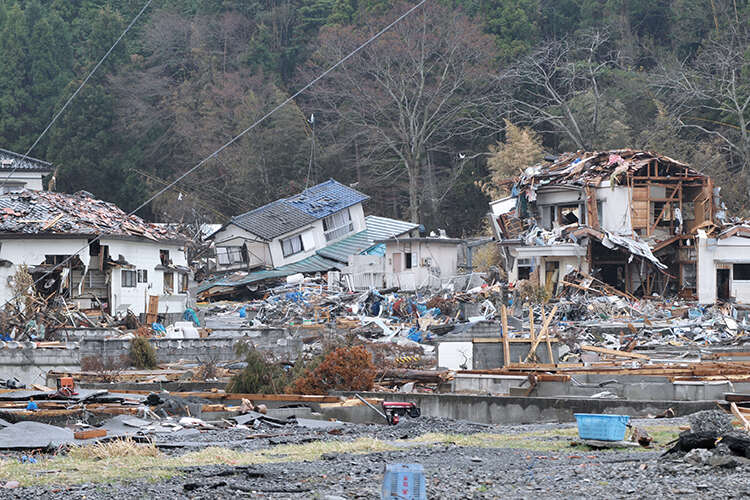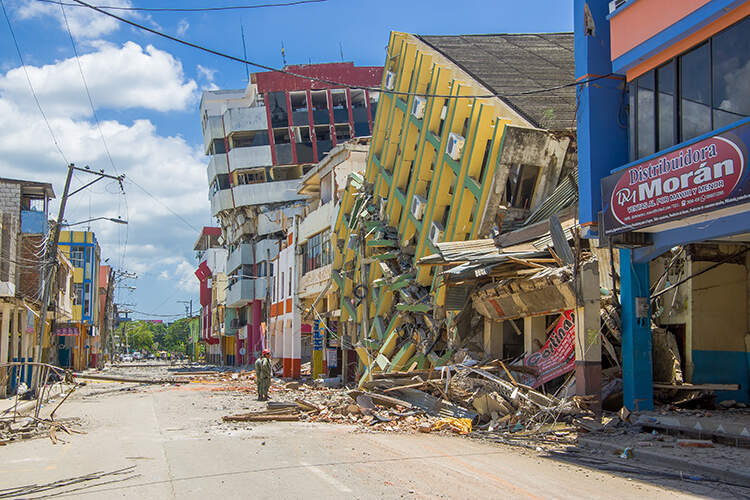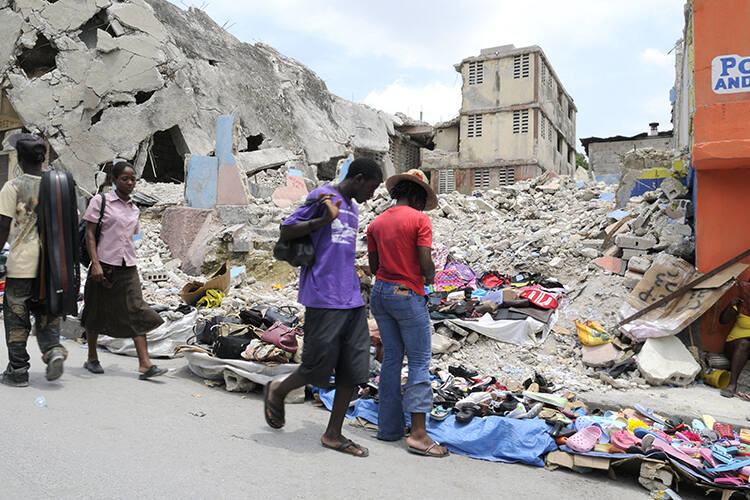
The countries that bear the greatest burden are often overlooked by the media
When the 9.1-magnitude Tohoku Earthquake struck the northeast coast of Honshu island, Japan, on 11 March 2011, it became the fourth largest earthquake ever recorded. It was also the most costly, causing approximately US$360 billion in damage to more than 330,000 buildings and triggering the Fukushima nuclear disaster. Yet while major earthquakes such as this one – and others in Japan, Indonesia and California – often make the headlines, experts say that these countries are not the ones most heavily affected.
Instead, researchers Max Wyss, Michel Speiser and Stavros Tolis of the International Centre for Earth Simulation Foundation argue that a key measure of the earthquake problem in a country is the ratio of fatalities to population size. They suggest that a new impact metric, which they call the Earthquake Fatality Load (EQFL), can be used to measure the level of population suffering in seismically active countries.
‘We wanted to look at how serious it is to absorb those losses, for a country,’ says Wyss. ‘When you do this quantitatively, the order of countries to worry about suddenly changes.’ Drawing on mortality and population data from 35 nations with at least 10,000 earthquake-related fatalities over the last 500 years, the researchers determined each country’s EQFL – the number of earthquake-related deaths per year per million inhabitants.
Collectively, these countries account for 97 per cent of all earthquake fatalities between 1500 and March 2022. All deaths from earthquake-caused tsunamis have been excluded from the study, which focuses instead on more immediate impacts, such as the collapse of buildings and other infrastructure.

Number of earthquake-related deaths per year (per million inhabitants)
450 deaths – Ecuador
Ecuador is a seismic hotspot due to its location on the South American Plate, wedged against the Nazca Plate. This constant collision creates friction, triggering frequent earthquakes. The most damaging quakes are intraplate ones, within the South American Plate itself, such as the devastating 1949 Ambato earthquake. According to the United States Geological Survey, the Ambato earthquake resulted in approximately 5,050 deaths
Megathrust events, powerful subduction zone earthquakes, also pose a serious threat. The 1906 Ecuador-Colombia earthquake, a megathrust, unleashed a destructive tsunami. Recent history isn’t tremor-free either. In April 2024, a significant earthquake struck off the coast, and this month (6 May), a 5.0 magnitude quake rattled northern Ecuador. Here is a list of notable recorded earthquakes in Ecuador.
380 deaths – Lebanon
Lebanon has a long history of earthquakes due to its location on the boundary of the Arabian and African tectonic plates. There are records of earthquakes dating back to 31 BCE, 363 CE, 749 CE, and 1033 CE. The worst in recent history was the 1759 earthquake, estimated at a magnitude of 7. It destroyed Beirut and surrounding areas and and its tremors were felt in Damascus 150 kilometres away in Syria. It claimed around 40,000 lives.
More recently, the 1956 earthquake measuring 6.0 caused significant damage and casualties, with 136 deaths and thousands of homes destroyed. Even smaller tremors, such as the 2008 5.2 magnitude quake, caused injuries and panic due to the vulnerability of some buildings.
220 deaths – Turkmenistan
While Turkmenistan is not as seismically active as some parts of the world, it does experience frequent small tremors, and its poor infrastructure makes its population particularly vulnerable.
A powerful 7.8-magnitude quake struck near Ashgabat in 1948, causing widespread damage and thousands of casualties. However, large earthquakes are uncommon, with tremors typically falling below 6.0 magnitude. Due to the region’s vulnerability to earthquakes and sometimes less-than-earthquake-resistant construction, even smaller quakes can cause damage and pose a threat.
Recent years haven’t seen any major earthquakes within Turkmenistan itself. However, tremors originating in neighbouring countries, such as the 2017 Western Iran earthquake, were felt in the eastern parts of Turkmenistan.
220 deaths – Haiti

Haiti’s history is intertwined with earthquakes as it sits on the boundary of the Caribbean and North American tectonic plates. Many of these earthquakes have been devastating due to the prevalence of poorly built structures. Major historical events include the 1751, 1770, and 1842 earthquakes, which caused widespread destruction in Port-au-Prince and Cap-Haïtien. The most impactful recent quakes were the 2010 magnitude 7.0 earthquake near Léogâne, claiming an estimated 300,000 lives, and the 2021 magnitude 7.2 earthquake near Petit-Trou-de-Nippes, which resulted in over 2,200 fatalities.
Read other Geographical earthquake stories
PREVENTING DISASTERS
Earthquake casualty numbers have decreased over time for all 35 countries – largely thanks to improvements in earthquake-resilient buildings, evacuation plans and rescue operations. Rural-to-urban migration could also be a factor, as research suggests that in some countries, many more casualties occur in remote, rural settings where infrastructure is less resilient and aid is further away. Italy stands out as having the smallest decrease, which researchers say is ‘likely because old buildings are preserved, renovated and lived in.’
110 deaths – Portugal
The Great Lisbon Earthquake in 1755 was the most devastating in Portuguese history. Estimated at a magnitude of 8.5-9.0, it triggered a massive tsunami that ravaged Lisbon and surrounding areas. The combined effects caused an estimated 60,000 deaths, leaving a lasting scar on the nation’s memory. The 1909 Andalusian earthquake, centered in southern Spain, heavily impacted Portugal, particularly the Algarve region. The 20th century also saw tremors in the Azores, a Portuguese archipelago, with the 1941 event causing significant damage on the island of São Jorge.
110 deaths – Iran
Located on several tectonic plates, Iran experiences frequent earthquakes, particularly along the Zagros Mountains fault line. The country has a long history of destructive quakes. The 856 Damغان (Damغان) earthquake, estimated at magnitude 8.0, is considered one of the deadliest. The 2003 Bam earthquake (magnitude 6.6) claimed more than 26,000 lives. Iran experiences tremors regularly. The 2017 Kermanshah earthquake (magnitude 7.3) caused widespread damage near the border with Iraq.
55 deaths – Turkey

Sitting on the Anatolian Plate, squeezed by several others, Turkey is highly prone to earthquakes. The region has faced destructive earthquakes for centuries. The 1939 Erzincan earthquake (magnitude 7.8) caused immense destruction and casualties exceeding 30,000. The 1999 İzmit earthquake (magnitude 7.6) and the 2011 Van earthquake (magnitude 7.2) were devastating events.
SMALL COUNTRIES, BIG LOSSES
While China, Iran and Turkey have suffered the greatest total number of earthquake casualties (two million, 420,000 and 320,000, respectively), Wyss, Speiser and Tolis reveal that smaller countries with smaller populations – such as Ecuador, Lebanon and Haiti – are the ones that bear the largest relative burden.
33 deaths – Italy

Italy’s location on the collision zone of the African and Eurasian plates makes it prone to earthquakes, particularly in the southern regions. Destructive earthquakes have plagued Italy for centuries including the 79 CE eruption of Mount Vesuvius, triggered by an earthquake. The 1908 Messina earthquake and tsunami (magnitude 7.1) resulted in an estimated 120,000 deaths.
19 deaths – China
China boasts some of the world’s earliest documented earthquake records, dating back thousands of years. Earthquakes occur throughout China, with a higher frequency in western provinces. Despite some notable exceptions, such as the 1556 Shaanxi earthquake (estimated magnitude 8.0-8.3), one of the deadliest in history, claiming hundreds of thousands of lives and the 1976 Tangshan earthquake (magnitude 7.8) causing an estimated 240,000 deaths, the country does appear higher in the table due to the lower overall number of smaller but still lethal earthquakes suffered by other countries.




